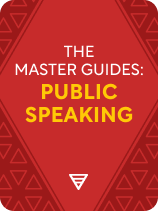

This article is an excerpt from the Shortform book guide to "The Master Guides: Public Speaking" by Shortform. Shortform has the world's best summaries and analyses of books you should be reading.
Like this article? Sign up for a free trial here.
What’s the best way to write a powerful speech? Can you learn how to write a prepared speech with impact?
To learn how to write a prepared speech that makes a lasting impression, you’ll need to consider strategies related to the following: your overall message, three or fewer key ideas to include, your opening, simplicity, engagement, and your closing. If you can do all these things well, you’ll have a very powerful speech.
Read on for more about speech-writing strategies for impactful public speaking.
Strategies for Writing a Speech with Impact
We’ve organized experts’ advice on how to write a prepared speech into six subtopics, ranging from choosing your message to writing a powerful closing.
Strategy #1: Create a Strong Message
In TED Talks, TED curator Chris Anderson suggests you begin writing your speech by determining your throughline—the lesson you want your audience to take away. Think of this as the point of your speech. For example, if your topic is your trip to Alaska during which you saw how the Inuits live, your throughline could be, “People who live in small, self-sufficient communities live more creatively than people in big cities.”
In Public Speaking for Success, Dale Carnegie adds that speeches tend to have one of four common goals:
- To elucidate and educate
- To persuade people of a position
- To inspire people to take action
- To captivate and entertain
Strategy #2: Outline No More Than Three Ideas
Once you’ve crafted your message, outline your ideas and plan how your speech will unfold. In Talk Like TED, Carmine Gallo recommends that, when choosing your talking points, you use the Rule of Three: Include a maximum of three ideas in any one speech. Research suggests that the brain can’t process more than three ideas at once, so if you add any more than this to your talk, your audience simply won’t remember them.
Gallo also suggests creating a message map—a one-page summary of everything you want to include in your talk—to help you plan so you know going into your speech what you’ll cover. Create one using three steps:
- Step 1: At the top of a sheet of paper, draw an oval. In the oval, write a short “headline” that summarizes the main message of your talk.
- Step 2: Draw three arrows pointing down from your headline. At the end of each arrow, write a sub-point that will support your overall argument.
- Step 3: Below each sub-point, write all of the supporting material you’re going to include when discussing it. In The 16 Undeniable Laws of Communication, John C. Maxwell suggests you support your talking points with data, stories, quotes, illustrations, and so on.
Carnegie offers another practical speech-planning technique: Dictate your speech to explore different ways of arranging the ideas. Speak aloud into a voice recorder as if you’re giving the speech, and you’ll begin to notice better ways of fitting the ideas together. Transcribe your dictations for editing in a word processor, and repeat this process until you’re sure of your structure.
Gallo’s and Carnegie’s techniques are mostly for you to conceptualize what you’ll be speaking about, but Maxwell advises that you also present your outline to your audience so they can see the skeleton of your speech and thus better follow your talking points. Experiment with ways to organize your points so that the audience can easily absorb them and see how they’re connected—for example:
- Number them (such as: “Five Things I Learned”).
- Arrange them in an acrostic (a word that uses each of its letters to spell out a new word or sentence—like: “How to PLAN: Pick a goal, Lay out your strategy, Adjust your priorities, and Notify your employees”).
- Use a common word in each of your major points (for example: “Find Your Purpose, Know Your Purpose, Use Your Purpose”).
Strategy #3: Create a Powerful Opening
Once you have an outline, write an opening for your speech that will hook your audience. Anderson explains that you only have about 60 seconds to keep your audience’s attention once you begin your speech. He suggests you say something dramatic within the first minute, show a fascinating image (this can be beautiful, confusing, or funny), or pique their curiosity with a question or counterintuitive statement.
Likewise, Carnegie recommends you keep your opening succinct by refining it to a sharp, powerful sentence or two. He adds that there are several weak ways of opening a speech that you should avoid:
- Don’t open with an apology. Often used to seem humble, this technique makes speakers look incompetent or unprepared and can annoy audiences.
- Don’t open with humor. Most speakers can’t pull off jokes, so you’ll most likely make the audience cringe and pull away emotionally.
- Don’t open too formally. Scripted, overly rehearsed, and/or dry openings easily lose the audience’s attention.
Strategy #4: Express Your Ideas Simply
Many experts suggest you express your ideas simply when writing your speech, which, as Maxwell explains, allows your audience to better understand and remember them.
In one of his other books, The Bezos Blueprint, Gallo offers tips you can use to keep your speech simple and clear:
Tip 1: Use simple language. Express your ideas simply enough that the average high school student could understand them. Maxwell expresses a similar sentiment but suggests using language that an eighth grader can understand.
Tip 2: Vary sentence length and structure, but use short sentences and simple words most of the time. The more complex, important, or stressful the subject matter, the more important it is to write plainly. Choose words of Anglo-Saxon origin rather than those of Latin or Greek origin—for example, a Latinate word might facilitate your efforts to sound smart, but an Anglo-Saxon word will help your audience understand you.
Tip 3: Use active language. Begin sentences with clear subjects and vivid verbs. This keeps the “action” moving and keeps your audience engaged.
Tip 4: Trim unnecessary words and ideas. Keep sentences short and direct by avoiding qualifiers and hedge words—they add fluff and feel indecisive. Likewise, Maxwell says you should trim excess information that might distract from your main points.
Strategy #5: Incorporate Engaging Content
To make your ideas more understandable and to captivate your audience, experts recommend that you incorporate a variety of engaging content into your speech. Let’s look at several ways you can do this:
Strategy 1: Tell stories. In How Highly Effective People Speak, competitive public speaker Peter D. Andrei explains that people understand the world through stories—it’s how we learn and how our ancestors passed down information over thousands of years. When an argument is presented as a story, we relate to the people in the story and imagine what it would be like if the same things happened to us. Andrei specifically recommends telling a story about a single person because this makes it easier for the listener to imagine themselves in the story.
Heinrichs adds that you should describe sensations in detail. For example, describe the scent of your childhood home or the feeling of your stomach dropping. This helps your audience “experience” the event alongside you, and they’ll react to it the same way you did.
Gallo offers additional recommendations for making your story more memorable. He suggests incorporating the following elements into your story:
- Unexpectedness: Make the story take a turn that the audience didn’t anticipate. You’ll shock people into paying attention to what you’re saying.
- Mystery: Keep your story’s outcome unknown for as long as possible. People crave the closure of knowing how a story will end and will keep listening until they get it.
- Heroes and villains: Give your audience some characters to root for and others to dislike. They’ll become engrossed in your story as they wait for the satisfaction of the hero triumphing and the villain getting their comeuppance.
- Adversity: Make sure that the main character of your story overcomes adversity at some point in the narrative. Your audience will be inspired by this battle against misfortune, and they’ll keep listening to find out whether the main character prevails.
Strategy 2: Use visuals. Maxwell suggests you use body language, visual metaphors, or actual visual aids like physical props and images to help illustrate your ideas. Andrei explains that memories based on visual perception stick out more clearly in our minds, so they’ll provoke a stronger emotional reaction and be easier to recall later.
Gallo provides an example of Amazon founder Jeff Bezos using a vivid metaphor to condense a complex idea: To illustrate his philosophy on team size, Bezos explained, “We try to create teams that are no larger than can be fed by two pizzas.”
Strategy 3: Engage multiple senses. Gallo recommends presenting content that triggers a combination of the senses of hearing, sight, and touch. It’ll help your audience to remember what you’ve said: Research has shown that multisensory experiences are much more memorable than single-sense experiences. For example, if you’re pitching a product, you could pass a prototype around your audience.
Strategy 4: Incorporate humor: Maxwell writes that getting your audience to laugh increases feelings of intimacy and makes them more receptive to your words. However, he suggests you only use humor if it comes naturally to you. Gallo adds that humor increases your likeability and suggests four ways to incorporate humor into your speeches and presentations:
- Share an anecdote: Relate a short, amusing story about an experience you—or possibly someone else—had.
- Make an analogy: Humorously draw attention to the ways in which two different things are similar (for example, “Attempting to run Congress without encouraging social relationships between its members is like trying to drive a car that doesn’t have any motor oil!”).
- Quote someone else’s funny comment: This might be anyone from a friend to a famous person.
- Show the audience a funny video or picture: Use one you’ve produced yourself or one produced by someone else.
Strategy #6: Create a Memorable Closing
Anderson writes that an audience will remember a talk based on how it ends. He provides several options for powerful closings:
Closing 1: Apply what you’ve discussed to a broader situation. For example, “If this management style can transform Fortune 500 companies, imagine what it could do in the White House.”
Closing 2: Declare a personal mission. End your speech by making a proclamation about how you are going to use this knowledge to improve the world.
Closing 3: Leave your audience with a dream. Paint a picture of a better world. Inspire your audience with your dream for the future—but be sure to avoid clichés.
Closing 4: Call them to action. Ask your audience to take the information you just gave them and do something with it. For example, “If we all contact our congressmen, they’ll have to listen.” Maxwell offers another tip for encouraging action: Help your audience imagine what the positive change looks like and show them how to take the first step.
Closing 5: End with beautiful language. A poetic statement, song lyric, or eloquent phrase can add a somber and memorable touch. Carnegie recommends using a famous quote if it more powerfully sums up your argument than you could.

———End of Preview———
Like what you just read? Read the rest of the world's best book summary and analysis of Shortform's "The Master Guides: Public Speaking" at Shortform.
Here's what you'll find in our full The Master Guides: Public Speaking summary:
- How you can master public speaking—even if you fear it more than death
- Insights from leading experts on how to prepare and deliver a speech
- How to keep your audience's attention and stop them from losing focus






